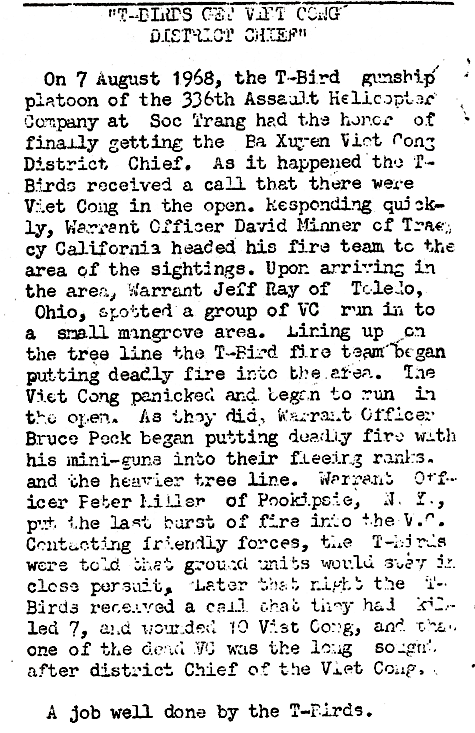The Press
These are Newspaper / Newsletter articles concerning the Unit and the Men of the 336th AHC.
Scanned copies are used whenever possible, but some are unreadable after scanning
and they have been retyped, or the only copy available was a typed copy.
Various Sources
"Charlie Goes To School - The Hard Way" | (Courtesy of Larry McCune) MACOI News Release, December 7, 1966
NEWS RELEASE
Cleared for release by MACOI, 7 December 1966
CHARLIE GOES TO SCHOOL – THE HARD WAY
SOC TRANG, Vietnam (336th Avn Co. IO) – Some 300 Viet Cong took a lesson in the “school of hard knocks” on a steaming Saturday morning near Ba-Tri in the Delta Region of South Vietnam recently. Some of the 300 will live to remember their lesson – others died without passing the final examination.
The lesson being taught was “don’t tangle with armed helicopters”. Teachers of the lesson were members of the “Thunderbirds”, the armed helicopter platoon of the 336th Assault Helicopter Company.
The Thunderbirds known locally as the “T-Birds”, were “scrambled” in response to a report that an ARVN patrol and its American advisor had been ambushed, and that the outpost of Ba-Tri was threatened by a large force of VC. When spotted by the “T-Birds”, the VC were disregarding all previous lessons and were walking in force through the open rice paddies.
Warrant Officer Peter J. Galanos of Los Angeles, California, a veteran of six months with the “T-Birds”, was one of the first to sight a group of VC moving on a dike between rice paddies. “We cut up the head of the column with our shipmounted M-60 machine guns and the rest of the VC jumped into the water” recall Galanos. After that it was a mad scramble. The VC in panic, were running in all directions. A few headed toward cover and the “T-Birds” attacked them with rockets and finished the job with machine guns.
While Galanos and his crew were taking care of these VC, another large group was spotted by Lieutenant Colonel James E. Kennedy of Austin, Texas, Commanding Officer of the 336th, and Major Louis A. Jacquay, Fort Wayne, Indiana flying in the company’s command and control ship. They directed another “T-Bird” fireteam to intercept this new threat.
Captain Teddy Allen of Monterey, California, armed helicopter fireteam leader, described this part of the action. “It was a classic example of the armed helicopter’s effectiveness against insurgents. We had them where we wanted them… out in the open. We had them! We knew it and they knew it too”.
But this part of the day’s lesson was not so easy. The Viet Cong blazed back in desperation with every automatic and small arms weapon they had. The armed helicopters flew through intense VC fire and took several hits, but continued to fly in seeking out Charlie with rockets and machine guns until this group too was disorganized and ineffective.
Every combat action brings out individual acts of courage and this was no exception. Specialist Fourth Class Richard A. Honyoust of Benton Harbor, Mich., was observed leaning far out over the helicopter’s skids delivering accurate machine-gun fire directly into the midst of the now terror-stricken Viet Cong. There were several bullet holes within inches of his legs and even nearer to the one strap that was the lifeline between himself and oblivion. Specialist Fourth Class Chester L. Groce of Chickamauga, Georgia picked up his M-14 rifle and continue to fire when his machine-gun ammunition was gone. All the T-Birds had been hit by the intense Viet Cong fire. The command and control aircraft had also been hit and Major Jacquay slightly wounded while their door gunners added firepower to that of the T-Birds during the engagement. Such acts were typical of the courage displayed that day by these American fighting men.
With all of their ammunition gone the T-Birds reluctantly broke off the attack leaving the command and control aircraft to keep tabs on the VC while they reloaded and rearmed. As the T-Birds returned to their base to rearm, a tail rotor control cable on one of the aircraft, which had been partly severed by a VC bullet, finally broke causing the helicopter to spin rapidly several times before the aircraft commander, Warrant Officer Galanos, was able to land. Demonstrating great professional skill, he landed the aircraft without further damage or injury to the crew.
After inspecting his helicopters, Captain Allen found only one, his own, able to fly back into action, and his crew eagerly volunteered to do just that. Meanwhile, the command and control helicopter had continued to deliver machine gun fire into the remaining enemy from an altitude of 700 feet, well within range of VC small arms fire. When the lone T-Bird returned to the scene of battle, it joined the command aircraft and engaged what was left of the enemy. Again they expended all their ammunition..
An American Sergeant, the advisor with the ambushed ARVN patrol had been captured earlier during the VC attack on the patrol. During the chaos caused by the T-Bird attack he escaped to freedom.
So ended one of the most successful engagements of its kind during this bitter struggle for the rice-rich Mekong Delta. The Viet Cong dared return only under the cover of darkness to drag away their dead. The T-Birds had done their job well.
"S. Viet Troops Kill 142 Reds, 3 Copters Lost" | (Courtesy of Archie Wallace) UPI article about an Operation near Vinh Long, Circa 1967
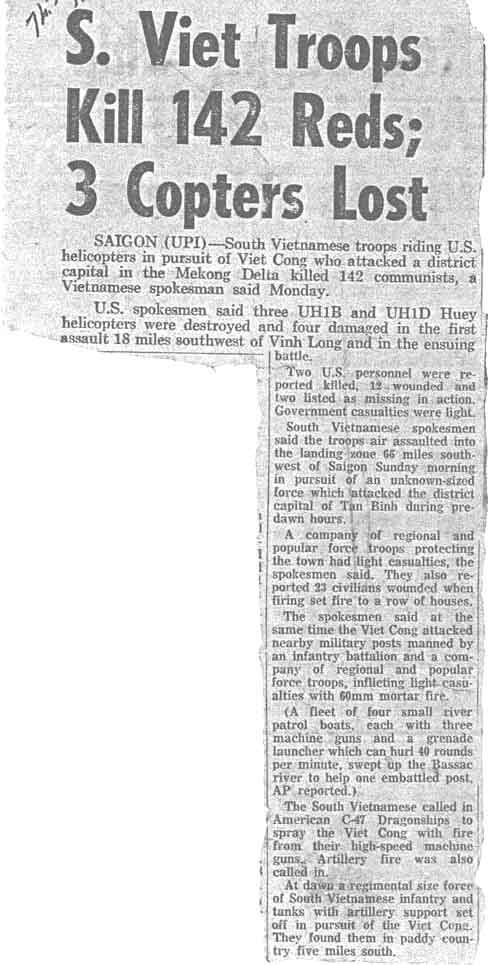
"S. Viet Troops Kill 142 Reds, 3 Copters Lost" | (Courtesy of Archie Wallace) UPI article about an Operation near Vinh Long, Circa 1967
1st Aviation Brigade HAWK Newsletter information
for 164 CAG
13 CAB
307 CAB
For date 680430
164 CAG was a US Army unit
13 CAB was a US Army unit
307 CAB was a US Army unit
Primary service involved, US Army
Phong Binh Province, IV Corps, South Vietnam
Location, Can Tho
Description: The 164th Combat Aviation Group joined the ranks of Army Aviation in a formal activation ceremony on February 1.
The Group had been activated by USARPAC General Order number 311 dated December 14, 1967. The new group is essentially the old 13th Combat Aviation “Delta” Battalion with a new name. The new group is composed of the 13th Battalion and the 307th Combat Aviation Battalion, formerly the provisional Phantom Battalion. COL Robert D. McDaniel, who has commanded the 13th Battalion since July, 1967, assumed command of the new group. In the new organization, the 13th Battalion, commanded by LTC James L. Tow, will move its headquarters to Vinh Long. The 307th will remain at Soc Trang, and the group quarters will be at Can Tho. With the establishment of the 164th, surveillance and target acquisition capabilities have been grouped under the Phantom Battalion and the assault and transport capabilities are under the 13th Battalion’s control. The 307th retains control of the 199th and 221st Reconnaissance Airplane Companies, the 244th Surveillance Airplane Company, and the 235th Huey Cobra equipped Armed Helicopter Company. The 13th Battalion consists of the 114th, 121st, 175th, and 336th Assault Helicopter Companies. The new group will provide greater flexibility and capability for the entire Delta region. “The chartering of the 164th Combat Aviation Group promises to better these achievement,” stated COL McDaniel in his speech. He then added, “I feel a certain sadness at turning over my command of the Delta Battalion, but I look forward to the challenges of commanding the Group.
The source for this information was Apr 68, Vol 1, Num 8 by Richard Calton
"Article about an Operation near Can Tho" | (Source Unknown), Circa 1968

Stars & Stripes
"T-Bird Unit Burns Out VC With Phosphorus" | (Courtesy of Robert Wardwell) Article from September 1, 1967
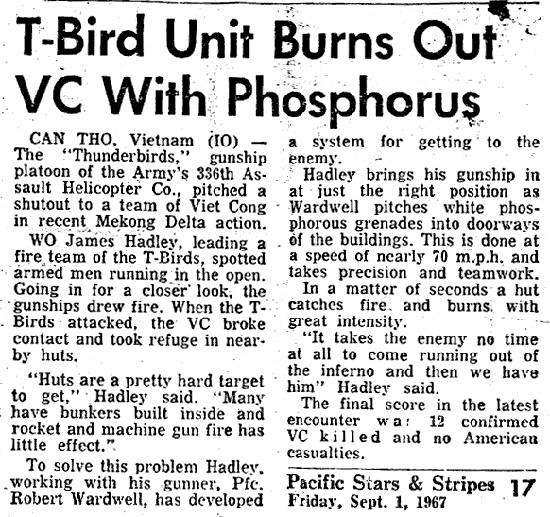
"Hot Time In The Delta" | (Courtesy of Robert Wardwell) Article from Circa 1967
Hot Time In The Delta
“I don’t want to set the world on fire, I just want to start a flame in your house”.
This might sound like an old song that has been slightly reworded, well it is, it’s only one of the adaptations that the T-Birds of the 336th Assault Helicopter Company have developed in their hunt for the Viet Cong of the Delta. When the monsoon rains of Vietnam put the Mekong Delta 90% under water, the Viet Cong is at his finest. He has the means of transportation by using the flooded land as a Navy uses the ocean. He has heavy cover in the greenery that abounds in the wet season and he is secure in the knowledge that the Americans can’t hurt him deep in his bunker. This is the way it was.
The T-Bird gun teams of the 336th Assault Helicopter Company have always had the problem of getting the Viet Cong out in the open, since the thatched huts were usually soaking wet, tracers couldn’t set them afire to flush the Viet Cong out. That was until Warrant Officer James A. Hadley of La Mesa, California, one of the T-Bird aircraft commanders had his gunner, SP/4 Bob Wardwell, Stanford, Connecticut, start practicing with a flare pistol. After a few days of practice, SP/4 Wardwell started to get pretty accurate with a weapon that was never designed for attack. Warrant Officer Hadley finally decided as to what type approach to the target would produce the best results.
All their homework was done, the only thing left was the actual test. They didn’t have to wait long for the opportunity to try their latest trick. The T-Birds came in over the trees towards the operational area. As they came roaring into the proposed landing zone, they were greeted by the 15 unhappy faces of the Viet Cong who were caught in the open. The gunships were flying too fast and too low and weren’t expecting the enemy so soon and so they couldn’t get all of the Viet Cong on the first pass. Nine of the Viet Cong managed to make it to a nearby hootch while their comrades went down under the guns of the T-Birds.
Now the final test had come, as the lead ship broke around to cover Warrant Officer Hadley’s ship, SP/4 Wardwell changed his M-60 for the flare pistol and leaned far out of the aircraft. As the hootch came into view under the right skid, Wardwell fired and watched it hit on target right through the door of the hootch. He later said “I was leaning so far out I felt like I was ready to fall, but I just has to watch that one round while it flew”. A second round through the roof of the building finished the job of igniting the soggy building. As Hadley’s T-Bird broke away from the hootch, the team leader who had been covering him saw the Viet Cong start to run out of the smoking and burning house, and rolled in on the attack. The rest of the Viet Cong squad that had wandered so foolishly into the open were now cut down, still wandering how those crazy gunships had set their wet hootch on fire.
Warrant Officer Hadley said later, “the hootches really burn quickly when that flare hits them. If we can stay supplied with flares, then we can burn down every hootch the Viet Cong use”.
"Jungle Rescue - Ordeal in VC's Back Yard" | (Courtesy of Larry McCune (VHPA)) Article from May 12, 1968
Pacific Stars and Stripes information
for 38 ARRS DET 10
336 AHC
For date 680512
38 ARRS DET 10 was a US Air Force unit
336 AHC was a US Army unit
Primary service involved, US Air Force
An Xuyen Province, IV Corps, South Vietnam
Location, Ca Mau
Description: The following is an edited version of an article titled “Jungle Rescue – Ordeal in VC’s Back Yard” by Bob Cutts S&S Correspondent.
Chet Walborn could see it all too clearly. The little FAC plane lay in the clearing on its back, a tangle of wreckage. Across the Son Qua Lon River were the VC positions – new bunkers and trenches. The outpost where the plane had crashed, Nam Can, was still a hornet’s nest of confusion. Surrounded by the U Minh Forest, the tiny post had been hit by more than 100 mortar shells before dawn. One Vietnamese soldier had died and nine were wounded. It was obvious the VC across the river did not intend to leave the outpost standing another night – not with two Americans in it. The Vietnamese in the outpost were milling around close to panic. FAC Walborn, circling in his own plane below the thick cloud cap knew help was on the way – but not how much. The jungle was ominously quiet. Walborn knew he was in a tight spot – Nam Can, 30 miles south of Ca Mau and the closest government outpost to the southern tip of the Mekong Delta was Charlie’s back yard. There was no way in except through the minute helipad next to the mud walls – it was practically a bull’s eye to the mortarmen who inhabited the U Minh. But the men on the ground FAC CPT Charles Louvern and his observer, Marine LTC Ted Culpepper, had to be gotten out – now. They had lost all oil when their engine took a hit earlier, and had no choice but to try to pancake down onto Nam Can’s helipad – there was nowhere else to go. North of Ca Mau, a solution was winging its way to the scene – Two H-43 Huskie rescue choppers: “Pedro 91” flown by Larry Conover, and “Pedro 39” piloted by Tom Precious were swooping in from the 38th Air Rescue Sq., Det. 10, at Binh Thuy AB, near Can Tho. It was a long flight, and Pedro 91, ten minutes ahead of its sister ship, was already low on fuel. Conover had to stop at Ca Mau for gas – circling the thick cloud roof, he finally found a hole and dove straight through it – he had only 20 minutes’ fuel left. This left Tom Precious and his crew, CPT Don Van Meter, copilot, Sgt. Jim Parks, pararescue, and SSGt. C. Touchette, crew chief, to make the pickup. Walborn had meanwhile scrounged up a three-copter fire team from the 336th AHC, the “T-Birds”. He told them to hold off above the clouds while he brought in the Husky figuring to surprise the VC with a split second pickup before they could open fire. He was wrong. As Precious came in on a beautiful pattern and flared to a landing six mortar shells hit all around him in a barrage. The jungle across the river exploded in a maelstrom of fire. Mortar flashes lit up the jungle like a pinball machine. “David 30”, as Walborn was call-signed, didn’t know it, but the entire U Minh-II battalion, reinforced by a heavy weapons company, was doing the shooting. It was the Yankees who got surprised. Touchette, who had left the Huskie to find the Americans, made a running dive for the open door, and Precious pulled out. The Americans were nowhere in sight. Everyone on the ground was running for bunkers. Now Precious was low on fuel and had to turn for Ca Mau. But Conover was airborne again and headed from Nam Can. Walborn knew the only hope of suppressing ground fire that heavy was with bombers, then gun helicopters. But T-Bird now had fuel problems, too. There was just enough left for 15 more minutes over Nam Can – not enough time for an airstrike. It would be now or, maybe, never. As Conover pulled into sight, David 30 decided to gamble. He asked T-Bird ships if they would try to suppress long enough for another rescue attempt. They said they’d try. He asked Pedro 91 if he’d go in. The helipad was still being splattered with mortars. “If the T-Birds’ll cover, we’re game.” OK, It was set. Swooping in low, one T-Bird Huey dropped two smoke bombs out across the river. Only one ignited. Then, in a beautifully coordinated pattern the three gunships swooped in across the river, blazing away with machineguns and rockets. Walborn flew low to draw fire off Nam Can. Behind them, Conover settled into Nam Can. Louvern, in sweat-stained flight suit, appeared. He ran to the helicopter dragging a badly wounded Vietnamese. But now, the panic-stricken Vietnamese soldiers started to rush the copter. They all wanted out of the outpost. There was of course no room in the tiny Huskie for 50 Vietnamese. They started to rock the plane. They were packed so close that Culpepper, in the background, couldn’t get near the plane. Conover hovered up a few feet off the deck, swept back and forth the force the Vietnamese to get their heads down. Finally he plopped down next to Culpepper – and the Vietnamese rushed him again. Culpepper, also unhurt made a flying leap into the copter. Meanwhile, the T-Birds were running into troubles – the VC were throwing mortar shells up into their paths. One chopper was hit, but stayed aloft. As Conover broke away, it was over. The helicopters disappeared toward Ca Mau. Things got quiet again. But Walborn, in David 30, knew where to look now. Scanning the skies, he saw the two fighters he had ordered coming in, and he put them to work. Napalm, rockets, bombs, and 20mm cannon wreaked vengeance on the U Minh II battalion.
The source for this information was 6805pss.avn supplied by Les Hines
"U Minh Gains Brings ARVN Smiles" | (Courtesy of Artie Van Zilen) Article about an Operation on September 15, 1970

"Viets Take Over Soc Trang Strip" | (Courtesy of Russ Marsden) Article about the Last Day at Soc Trang, Circa 1970
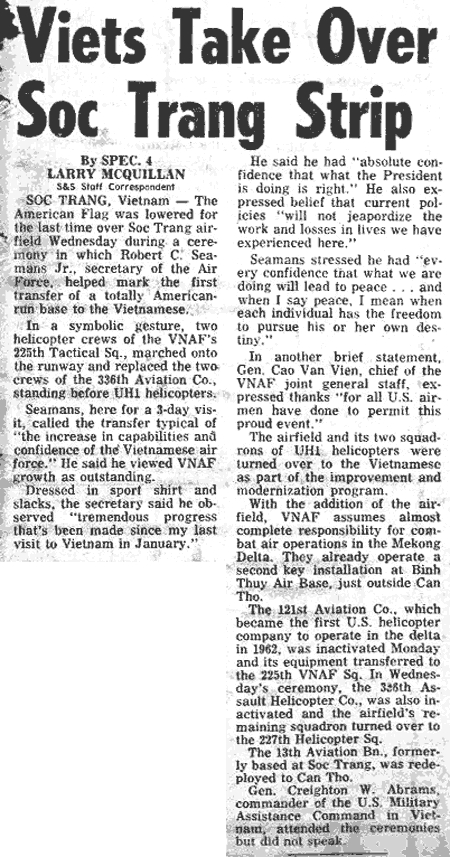
The Army Reporter
"US Stage Joint Operation In Mekong Delta" | (Courtesy of Larry McCune (VHPA)) Article from January 6, 1968
Army Reporter information
for 13 CAB
1 BDE 9 INF
3 BDE 9 INF
336 AHC
For date 680106
13 CAB was a US Army unit
1 BDE 9 INF was a US Army unit
3 BDE 9 INF was a US Army unit
336 AHC was a US Army unit
Primary service involved, US Army
Operation CORONADO IX
Dinh Tuong Province, IV Corps, South Vietnam
Description: The following is an edited version of an article titled “US Stage Joint Operation In Mekong Delta” dated 6 Jan 1968.
Army aviation helped Vietnamese and United States forces take a big step forward when they recently staged an operation together in the Mekong Delta. Operation Coronado IX was composed of elements of the ARVN 7th, 9th, and 21st Inf Divs, plus the 1st and 3rd Bdes of the U.S. 9th Inf Div. Supported by the 13th CAB, which provided troop transport and armed helicopter support, the ground forces were able to inflict heavy losses on the enemy in Dinh Tuong Province. The operation was staged at Vinh Long. The LZs were pounded by Air Force F100 jets for 10 minutes before the lift to insure a safe landing for helicopters and ground troops. There were no helicopters downed by enemy gunfire, but a medevac chopper form the 82nd Med Det had to abort his mission because of heavy ground fire. The second day of Operation Coronado IX was again staged at Vinh Long and ground troops were airlifted into the combat area around 7 a.m. Again the LZ was pounded by the Air Force jets, but this time the enemy was dug in deep. The first wave of helicopters was met by heavy automatic weapons and mortar fire. Ground troops were pinned down in the LZ for the entire day. On the seventh day of Operation Coronado IX 7th ARVN Inf Div intelligence received word that the VC were planning to attack an outpost in the operational area. Three gunships from the 336th AHC were called in to help defend the outpost when it was attacked late that night. They provided support to the besieged outpost and drove off the VC. When the VC retreated they left behind 11 dead soldiers and eight destroyed sampans. “The purpose of this whole joint operation is to rid the Dinh Tuong Province of a long-time enemy sanctuary,” said LTC Charles Hutchins, 13th CAB operations officer
The source for this information was 6801AR.AVN supplied by Les Hines
"Edited version from the weekly Vietnam Communique column" | (Courtesy of Larry McCune (VHPA)) Article from March 30, 1968
Army Reporter information
for 1 AVN BDE
71 AHC
14 CAB
23 INF DIV
For date 680330
1 AVN BDE was a US Army unit
71 AHC was a US Army unit
14 CAB was a US Army unit
23 INF DIV was a US Army unit
Primary service involved, US Army
South Vietnam
Description: The following is an edited version from the weekly Vietnam Communique column in the 30 Mar 1968 issue.
Gunship crews of the 71st AHC, 14th CAB reported killing 20 VC while flying close overhead armed reconnaissance for infantrymen of the Americal Div’s 1/62nd Inf. The ground units were conducting a reconnaissance operation seven miles south of Hoi An when they came into heavy contact with an enemy force. In addition to the 20 reported kills, the chopper gunners destroyed 18 structures, damaged 24 others and sank four sampans. The 13th CAB reported killing 15 VC while supporting ARVN infantry elements in several engagements in the Mekong Delta. Gunners of the 336th AHC conducted an aerial reconnaissance mission near the Soc Trang airfield. During the mission they reportedly killed seven VC. They also destroyed three enemy fortifications and sank 25 sampans. Crews from the 121st and 175th AHCs flew close support for a 21st ARVN Div unit south of Can Tho. The crews reported killing 26 VC in the operation
The source for this information was 6805AR.AVN supplied by Les Hines
"Edited version from the weekly Vietnam Communique column" | (Courtesy of Larry McCune (VHPA)) Article from May 18, 1968
Army Reporter information
for 336 AHC
13 CAB
121 AHC
175 AHC
For date 680518
336 AHC was a US Army unit
13 CAB was a US Army unit
121 AHC was a US Army unit
175 AHC was a US Army unit
Primary service involved, US Army
Ba Zuyen Province, South Vietnam
Location, Soc Trang
Description: The following is an edited version from the weekly Vietnam Communique column in the 18 May 1968 issue.
The 13th CAB reported killing 15 VC while supporting ARVN infantry elements in several engagements in the Mekong Delta. Gunners of the 336th AHC conducted an aerial reconnaissance mission near the Soc Trang airfield. During the mission they reportedly killed seven VC. They also destroyed three enemy fortifications and sank 25 sampans. Crews from the 121st AHC and the 175th AHC flew close support for a 21st ARVN Division unit south of Can Tho. The crews reported killing 26 VC in the operation
The source for this information was 6805AR.AVN supplied by Les Hines
"Edited version from the weekly Vietnam Communique column" | (Courtesy of Larry McCune (VHPA)) Article from August 17, 1968
Army Reporter information
for 1 AVN BDE
71 AHC
14 CAB
121 AHC
For date 680817
1 AVN BDE was a US Army unit
71 AHC was a US Army unit
14 CAB was a US Army unit
121 AHC was a US Army unit
Primary service involved, US Army
Quang Tin Province, I Corps, South Vietnam
Location, Chu Lai
Description: The following is an edited version from the weekly Vietnam Communique column in the 17 Aug 1968 issue.
Pilots and door gunners this week killed 333 enemy. While flying a reconnaissance mission near Chu Lai, CPT Herman Castle of the 71st AHC, 14th CAB noticed that a Marine jet airplane had ditched in the ocean. He quickly proceeded to the area. Though not equipped for rescue operations, CPT Castle and crewmen succeeded in pulling the Marine aviator out by having him hang on to the skids of the gunship. The pilot then flew to a beach where an ambulance was waiting to take the pilot to hospital for treatment. Gunship crews of the 121st and 336th AHCs, 13th CAB flew troop transport escort and armed aerial reconnaissance missions for elements of the 9th Inf Div. The infantrymen were conducting search operations 45 miles SW of Can Tho. Light contact was reported throughout the OA and the gunners killed 12 enemy. Infantrymen sweeping the area confirmed the kills
The source for this information was 6808AR.AVN supplied by Les Hines
"Edited version from the weekly Vietnam Communique column" | (Courtesy of Larry McCune (VHPA)) Article from September 28, 1968
Army Reporter information
for 336 AHC
13 CAB
A/7/1 CAV
9 ARVN DIV
For date 680928
336 AHC was a US Army unit
13 CAB was a US Army unit
A/7/1 CAV was a US Army unit
9 ARVN DIV was a Vietnamese Army unit
Primary service involved, US Army
Vinh Binh Province, IV Corps, South Vietnam
Location, Tra Vinh
Description: The following is an edited version from the weekly Vietnam Communique column in the 28 Sep 1968 issue.
Helicopter crews from the 1st Avn Bde reported killing 36 enemy soldiers and destroying numerous structures and sampans. Elements of the 164th CAG reported killing 26 enemy soldiers while flying in support of ARVN infantry units in the Mekong Delta. Helicopter crews of the 336th AHC, 13th CAB reported killing 11 as they supported soldiers of the 9th ARVN Div 13 miles SW of Tra Vinh. Helicopter crews from A/7/1st Air Cav killed four VC 12 miles north of Sa Dec. In the same area, they destroyed 21 enemy fortifications and sank 14 sampans
The source for this information was 6809AR.AVN supplied by Les Hines
"Edited version from the weekly Vietnam Communique column" | (Courtesy of Larry McCune (VHPA)) Article from November 11, 1968
Army Reporter information
for 336 AHC
13 CAB
164 CAG
From date 681022 to 681028
336 AHC was a US Army unit
13 CAB was a US Army unit
164 CAG was a US Army unit
Primary service involved, US Army
Vinh Binh Province, IV Corps, South Vietnam
Location, Tra Vinh
Description: The following is an edited version from the weekly Vietnam Communique column in the 11 Nov 1968 issue.
Helicopter crews of the 1st Avn Bde reported killing 42 enemy soldiers and sinking 86 sampans. On Oct 25 helicopter gunship crews from the 164th CAG reported killing seven enemy, sinking five sampans and destroying 25 enemy fortifications. Chopper crews from the 336th AHC, 13th CAB reported killing two VC, sinking four sampans and destroying 13 fortifications in scattered contacts centered 10 miles NW of Tra Vinh. In an action earlier in the week helicopter crews from the 336th AHC, 13th CAB, 164th CAG reported killing 10 VC, sinking 59 sampans and destroying 17 structures while supporting ARVN infantry operations in the area
The source for this information was 6811AR.AVN supplied by Les Hines
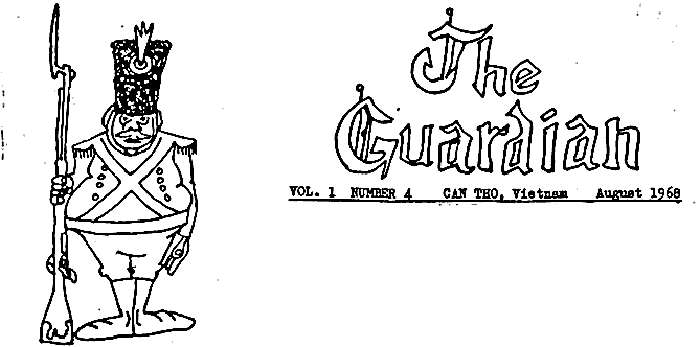
The Guardian (13th CAB Newsletter, Can Tho)
"T-Birds Receive Plaque" | (Courtesy of Alan Gustafson) Article from August 1968
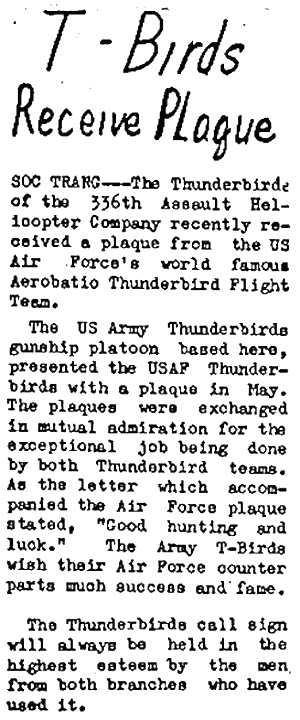
"Awarded: DSC to Aviator" | (Courtesy of Alan Gustafson) Article Circa 1968 about Capt. Knight receiving the DSC.
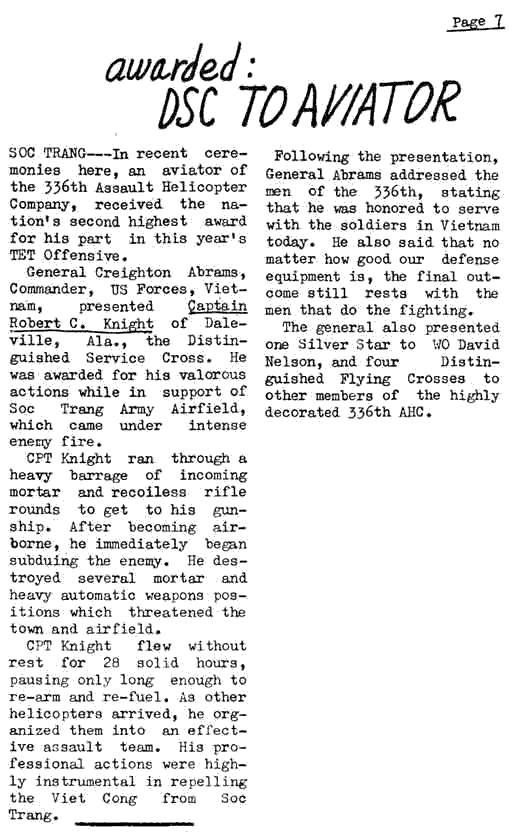
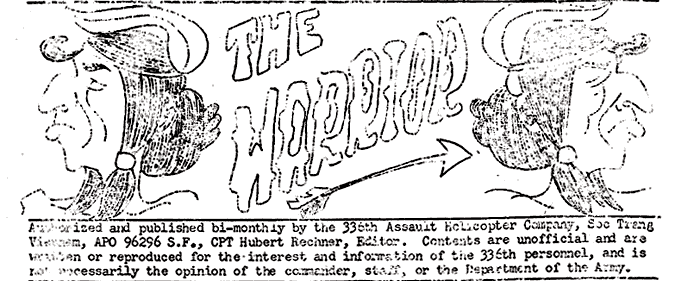
The Warrior (336th AHC Newsletter, Can Tho)
"T-Birds get Viet Cong District Chief" | (Courtesy of Larry McCune) Vol. 1, Edition 4, September 1, 1968
